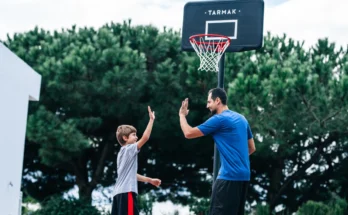Do you know How to jump higher in basketball?
Learn to leap higher to improve your performance in sports like basketball, volleyball, and track and field. You’ll also gain strength, agility, and balance, all of which can enhance your athletic and functional movements.
To increase the height of your vertical leap, you can engage in several different exercises. Continue reading for tips on how to perform them correctly, tips on how to leap higher, and other ways to remain healthy.
Increasing Jump Height
Here are some tips for measuring your jump height and improving it.
- Calculate the jump. Test your current level of leaping prowess to set a baseline first. Simply stand near a tall wall, put a piece of looped tape on the tip of your middle finger, extend your arm as high as you can, and connect the tape to the wall without using any extra equipment. Recreate the procedure with a new piece of tape, leaping before you stick it to the wall this time. To determine your current vertical leap, use a tape measure to measure the distance between the two pieces of tape.
- Keep your core in mind. As you practice your jump form and posture, keep your hips and core tight. Instead of slowing down immediately before a leap when you’re running to gain momentum, ramp up the pace as you get closer to the jump. Utilize your arms to gain height.
- Work on your balance and stability. Your stability and balance will improve if you perform stability ball exercises, crunches, and other ab workouts regularly.
- Strengthen your legs. To give yourself a strong foundation, strengthen your legs with exercises like lunges, barbell deadlifts, calf raises, and jump squats. Numerous squatting exercises, including split squats, single-leg squats, and back squats, might also be advantageous. Make sure your body is in the right position. For instance, the ideal squat position is when standing with your feet shoulder-width apart.
- Engage in some leaping drills. Burpees, jumping jacks, and jumping rope are examples of exercises that naturally incorporate jumping. These exercises will increase your repetition count and benefit both your overall strength and cardiovascular fitness.
- Consider performing plyometric workouts. You could improve your explosiveness by doing plyometric activities. Plyometric exercises like depth jumps and box jumps are two examples. You take a step off of a starting point on a box when you depth leap. As soon as your feet hit the earth, you leap up quickly and forcefully. Additionally, broad leaps could improve your ability to move quickly and build stronger legs.
- Work on leaps unique to your sport. When practicing this technique, you can mimic your jumping motion. While a volleyball player could practice the approach and leap for spiking the ball, a basketball player might practice a jump for a dunk, rebound, or lay-up.
Tips About How to Increase Your Vertical Jump
Consider this advice as you continue your vertical leap training:
- Warm up to get ready. Start with getting warmed up. Stretching your muscles “cold,” or after being completely still or at rest, can shock them and put undue strain or harm on them. Instead, get your heart rate up and your blood flowing to your muscles by doing a fast walk, jogging while still, or another quick aerobic workout before leaping.
- Adopt the appropriate forms. Incorporating new jumps or jump exercises, focus on the perfect form above height. With proper form, you’ll grow taller and experience a decreased chance of injury.
- Leap onto the soft ground. Practice your leaping on foam tiles or exercise mats to ensure a soft landing and minimize injuries.
- Allow your body to recuperate. If you’ve been pushing yourself a lot and feel that your explosive movements aren’t as good as normal, think about giving yourself some rest time before starting training again.
- Employ a coach (optional). Consider hiring a personal trainer or coach to create a customized jump-training program for you with exact sessions and reps to improve.
What is Power?
Force times velocity equals power.
Force and velocity, as they relate to the vertical leap, are a person’s maximum strength and speed, respectively. If you increase your strength and speed in your body weight, your vertical jump will get better. the broad principle that millions of professional athletes have followed. It is that simple.
What is Strength?
The most effective exercises to utilize to assess your strength when it comes to the vertical leap are the full Olympic back squat, front squat, power-lifting squat, box squat, and deadlift. If you can lift more weight in any of these exercises proportional to your body weight, your vertical jump will increase.
What is velocity?
Velocity describes the speed at which a vertical leap is performed. A quick motion is vertical leaping. The majority of vertical leaps usually last two seconds or fewer. If you move swiftly, you can benefit from your strength. Exercises that boost your velocity include deep jumps, shock jumps, broad leaps, and even simple leaping.
Can You Increase Your Jump Height?
You may increase your vertical jump height with regular practice. Similar to other physical gains, your vertical leap may be improved with the correct training and muscle strength.
What Muscles Are Used for Jumping?
Your lower body muscles, including your glutes, quadriceps, hamstrings, and calves, drive your body forward as you leap. These muscles work together to enable you to leap higher. Each of them serves important unique roles in jumping.
Your hamstrings help with hip extension and knee flexion, your quads help with a strong takeoff, and your calves help with stability and ankle flexion. Utilizing your core muscles as well as other upper body muscles in your arms, shoulders, and back can enable you to leap higher. So, to leap, you need to use all of your muscles, not just your legs.
How Often Should I Practice Jumping?
While you practice your leaps three to four times each week, give yourself time to recover between sessions. Given that jumping is a high-intensity, high-impact activity, trainers occasionally disagree on the ideal amount of jumpers’ weekly training sessions. Additionally, overdoing it increases your chance of damage.
Working with a personal trainer or experimenting with different weekly jump-training session counts can help you develop a customized training schedule that is effective for you.
How to Exercise Safely and Avoid Injuries?
If you have had any prior medical difficulties, see your doctor before beginning an exercise regimen. Proper exercise technique is essential to preserving the safety and effectiveness of a workout program. To obtain the greatest results, you may still need to modify each workout based on your unique needs. Always pick a weight that gives you total control over your body while you’re exercising. Pay close attention to your body’s signals when exercising and stop immediately if you feel any pain or discomfort.
Why do Basketball Players Jump When they Shoot?
How to Increase Your Vertical Jump for Basketball at Home
Why do Basketball Players Lose Their Hair?
FAQs
What is the secret to achieving higher jumps?
The secret to high leaping lies in physics. It all comes down to one simple concept: improve your body weight to power ratio overall. If you can do this, hypothetically your vertical jump will need to increase.
Which muscle groups help you jump higher?
What Muscles Aid in Jumping? Your lower body muscles, including your glutes, hamstrings, quadriceps, and calves, drive your body forward as you leap. These muscles work together to enable you to leap higher. Each of them serves important unique roles in jumping.
Do bigger legs make you jump higher?
Increase your muscle-to-body weight ratio to gain more power. To do this, work on your lower body strength with free weights two to three times each week. If your leg and calves are stronger, you can leap higher.
Do you jump higher with one leg or two?
As a result, the best option for jumping high depends on an individual’s level of mobility. When jumping from a standing position, two feet may lift you off the ground more effectively than one foot can. If you can take a rapid step before jumping, you might be able to jump a little bit higher.
Can shoes help you jump higher?
The bulk of sports shoe makers focus their research and development efforts on shock absorption and cushioning. The capacity of an athlete to enhance vertical jump is not greatly affected by this, even though it is undoubtedly important for the manufacture of sports footwear.




